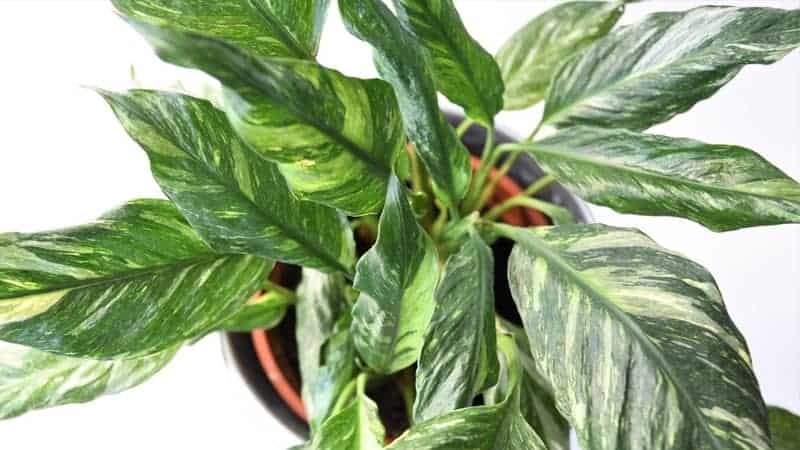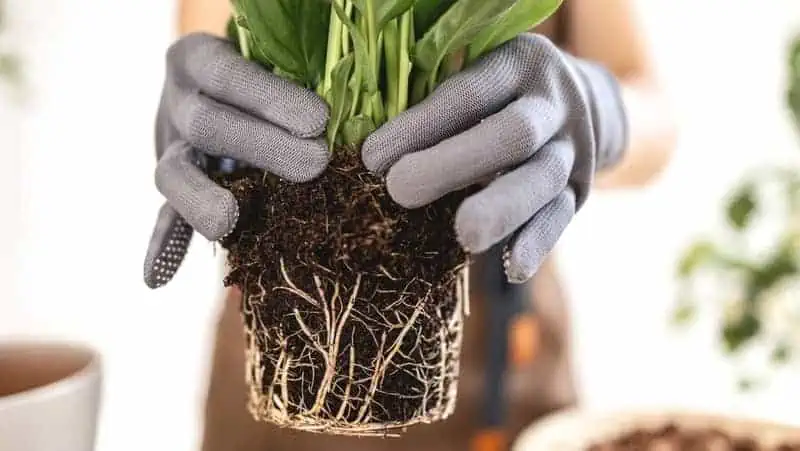Can you re pot peace lily while flowering?
Re potting is a crucial part of peace lily care, ensuring the plant’s continued growth and well-being. This process provides a larger pot, fresh soil, and improved root health, thereby promoting its long-term health and allowing it to produce its signature white blooms.
Why is Re potting Important?
Re potting a peace lily is important for several reasons:
- Space: As your plant grows, its roots require more room to spread out and develop properly. Re potting provides your peace lily with a larger container to accommodate this growth.
- Fresh soil: Over time, the nutrients in the potting mix become depleted. Re potting introduces fresh soil, ensuring your plant receives the nutrients it needs to grow and bloom.
- Root health: When a peace lily becomes root-bound, its roots can no longer absorb water and nutrients efficiently. Re potting prevents root-bound issues and promotes healthy root development.

When to Re pot Your Peace Lily
There are a few key signs that it’s time to re pot your peace lily:
- Root visibility: If you notice roots growing out of the drainage holes or over the edge of the pot, it’s time to repot.
- Soil depletion: If the soil dries out quickly after watering or has become compacted, it’s time to repot.
- Slowed growth: If your peace lily isn’t growing or blooming as well as it used to, it may benefit from repotting.
Repot your peace lily every 1-2 years or when you notice signs of growth, especially in spring and early summer, as the plant is in its active growth phase.
in your opinion: Do peace Lilies like big pots?
Tools You Need to Repot a Peace Lily Plant
When repotting a peace lily plant, gathering the necessary tools and materials is essential to ensure a smooth and successful process.
Here’s a list of items you’ll need:
To repot a peace lily plant, choose a larger pot with drainage holes and a high-quality, well-draining potting mix. Use perlite or vermiculite materials for improved soil aeration and drainage. Use a small trowel or scoop for easy soil transfer. Trim away damaged or unhealthy roots with sharp scissors or pruning shears. Wear gardening gloves to protect hands from soil and potential skin irritation. Spread newspaper or drop cloth on workspace to catch spills. Have a watering can ready to thoroughly water the plant. If desired, use a pebble tray to maintain humidity around the plant. Remember to wear gardening gloves, newspaper, and a drop cloth for easy cleanup.
How to Re pot Peace Lilies
Step 1: Choose a new pot
To ensure peace lilies thrive, replace the current pot with a larger container with drainage holes to prevent root rot and water logging.
Step 2: Prepare the potting mix
To achieve optimal moisture retention and drainage, mix high-quality, well-draining potting soil with per lite or vermiculite in a 3:1 ratio in the same pot.
Step 3: Remove the plant

Step 4: Inspect and trim the roots

Step 5: Add soil to the new pot
Place the potting mix at the bottom of the new pot, ensuring the peace lily remains at the same height as in the previous pot.
Step 6: Position the plant
Place the peace lily in the new pot, spreading its roots out over the soil layer.
Step 7: Fill with soil

Gently distribute the remaining potting mix around the plant, ensuring air pockets are eliminated and leaving 2 cm of space between the soil surface and pot rim for watering.
Step 8: Water thoroughly
Water your peace lily until the excess water drains from the pot’s bottom, allowing the soil to settle around the roots.
Step 9: Post-reporting care
Maintain your peace lily’s usual care routine by placing it in a bright, indirect light spot and monitoring its moisture levels. Water when the soil feels dry, and avoid over watering, as the new pot and soil may retain water differently.
Step 10: Monitor progress
Following reporting, monitor your peace lily for signs of stress or transplant shock, such as wilting, yellowing leaves, or slowed growth. Be patient and consistent with care, as your plant should recover within a few weeks and resume its regular growth pattern.
Should You Divide or Re pot Your Overgrown Peace Lily?
Re potting or dividing peace lily plants depends on the desired outcome and the plant’s overall health.
Re pot
Re potting is a recommended method for maintaining or allowing a peace lily to grow larger. This involves moving the entire plant to a larger pot, providing more space for roots and fresh soil, resulting in increased foliage and blooms.
Divide or split
Divide your peace lily variety into smaller plants with their own root system and foliage. This method is ideal for sharing plants with friends or creating more plants for your collection. Ensure each division has a healthy root system and at least one or two leaves. If unsure, consider factors like size, growth, and desired plant size.
Desired outcome
Re potting for larger plants is the optimal method, while dividing for multiple smaller plants is the best approach.
Plant health
Divide your peace lily if it’s healthy and thriving, or if it’s struggling or has damaged roots, to remove unhealthy parts and promote new growth.
Available space
Dividing your overgrown peace lily depends on your space and plant preference. If you have limited space and prefer smaller plants, divide them, while re potting larger plants is suitable for those with ample space. Both options can promote growth and well-being of your peace lily when done correctly.
Reducing the Risk of Transplant Shock
Transplant shock is a common issue faced by peace lilies during re potted or transplanted procedures. To reduce the risk, follow these tips:
Re potting a peace lily during its active growth phase, usually in spring or early summer, allows the plant to recover quickly from stress. Choose a pot with proper drainage and use a high-quality potting mix with per lite or vermiculite for a suitable environment. Water the plant well before re potting to ensure it is well-hydrated. Be gentle with the roots when removing the peace lily from its current pot and place it in the new one to avoid damage. Maintain the original soil level, as burying the plant too deep or too shallow can stress it. Avoid excessive root pruning, as it can cause additional stress. Water thoroughly after re potting to help the soil settle around the roots and reduce air pockets that can cause root damage. Provide proper post-re potting care, placing the peace lily in a bright, indirect light spot and maintaining its usual care routine. Avoid extreme temperatures or direct sunlight during the first few weeks. Be patient, as the peace lily may take a few weeks to recover and show new growth. Monitor the plant’s progress and provide consistent care during this period.
FAQs
How to loosen a peace lily root ball?
Loosening a peace lily root ball is crucial for re potting or dividing the plant, especially if it is root-bound. Gently remove the plant from its current pot and examine the roots for signs of rot, damage, or entanglement. Gently massage the root ball with your fingers to loosen the soil and de tangle the roots. Start at the bottom and work your way up, gradually untangling the roots and spreading them out. If the roots are extremely compacted and difficult to separate, make 2 cm vertical cuts to encourage growth outward. Use clean, sharp scissors or pruning shears to remove damaged or excessively long roots. Once the root ball is loosened and roots are untangled, proceed with re potting or dividing the peace lily.
Do peace lilies need big pots?
Peace lilies can adapt to various pot sizes, but their size affects their overall size and growth. Proper drainage and root development in a pot are essential for their growth and thrive, as long as the pot is large enough.
Can you re pot peace lily while flowering?
Re potting a peace lily during flowering is best to avoid stress and potential damage to the blooms. Re potting is only necessary when the plant is suffering from severe issues like root rot, pests, or overcrowded roots. If re potting is unavoidable, provide extra care and post-re potting care to ensure the plant’s health and well-being.
Can you re pot a dying peace lily?
Re potting a dying peace lily can help revive it if root problems or inadequate growing conditions are the root cause. However, it’s crucial to identify the root cause and address any underlying issues during the re potting process.
Should you re pot a peace lily with root rot?
Re potting peace lilies with root rot is often necessary to save the plant and aid its recovery, as it is often caused by over watering or poor drainage.











